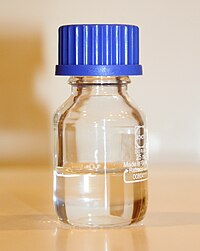
Photo from wikipedia
Abstract A new complex, Co(Htpc)2(H2O)2 (1) (Htpc = 5-(trifluoromethyl)pyridine-2-carboxylic acid), has been synthesized and characterized by X-ray single-crystal diffraction, elemental analysis, infrared spectral analysis, and thermogravimetric analysis. Meanwhile, the optimized… Click to show full abstract
Abstract A new complex, Co(Htpc)2(H2O)2 (1) (Htpc = 5-(trifluoromethyl)pyridine-2-carboxylic acid), has been synthesized and characterized by X-ray single-crystal diffraction, elemental analysis, infrared spectral analysis, and thermogravimetric analysis. Meanwhile, the optimized geometric structure of the ligand was determined using the M06-2X functional of density functional theory (DFT) with the 6-311 + G(d, p) basis set. The gap energies ΔE between the frontier molecular orbitals were computed in different solvent media (water, methanol and ethanol) using the time dependent density functional theory (TD-DFT)/M06-2X by applying the Polarizable Continuum Model (PCM). The coordination sphere around Co(II) is distorted octahedral with two chelating tpc- ligands and two coordinated water molecules. Bovine serum albumin (BSA) binding properties of the ligand, CoCl2·6H2O and 1 were investigated by fluorescence and UV–Vis absorption spectroscopy, revealing 1 exhibits higher binding affinity with BSA than free ligand and CoCl2·6H2O. ΔG, ΔH and ΔS at 298 and 308 K manifested that van der Waals interactions and hydrogen bonds were the main forces in the binding process. Graphical Abstract
Journal Title: Journal of Coordination Chemistry
Year Published: 2019
Link to full text (if available)
Share on Social Media: Sign Up to like & get
recommendations!